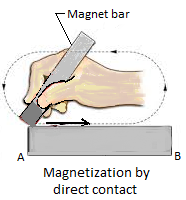Magnetization and Demagnetization
We will discuss here about magnetization and demagnetization.
What is magnetization?
The method of developing the properties of a magnet in a magnetic substance is known as magnetization. A magnetic substance like a piece of iron can be magnetized by electric current or by touching with a magnet. We know about the method of preparing an electromagnet and now we will discuss about the method of preparing a magnet by direct contact.
Take an ordinary bar (AB) made of iron magnetic substance).
Place it on a table and hold it firmly with left hand. Now take a strong magnet bar. Hold it with right hand in a fixed inclined position. Bring one pole of the bar magnet in contact with end A of the iron bar as shown in the figure. Now rub it down to end B of the bar along the surface. Repeat the process several times. After a few minutes the iron bar will turn into a magnet bar.
What is demagnetization?
The method of removing of the magnetic properties of a magnet is known as demagnetization. It can be done by the following methods:
1. Hitting a magnet heavily by hammer.
2. Heating a magnet at high temperature.
3. Placing two magnets with same poles facing each other.
The following uses of magnet are:
(i) Magnet is used to prepare mariner’s compass.
(ii) Electric bell and air pumps used in aquarium, are prepared with electromagnet.
(iii) Magnet is the main component of all types of speakers, telephone receivers, head phones etc.
(iv) Magnet is used to fix the door of a refrigerator.
(v) In factories heavy iron articles are lifted by very strong electromagnets
(vi) Specially designed electromagnets are used to remove iron fillings from the eyes.
From Magnetization and Demagnetization to HOME PAGE
Recent Articles
-
What Is Plasma? | Blood Plasma | Proteins | Nutrients | Cholesterol
Nov 07, 25 10:29 AM
Blood is a mobile fluid which is a connective tissue and is derived from the mesoderm like cell any other connective tissue. Colour of blood is reddish and that flows inside the blood vessels by means… -
Disorders of Respiratory System | Tuberculosis | Pleurisy | Emphysema
Oct 28, 25 11:39 PM
Tuberculosis is very common disease and is caused by a type of bacteria called Mycobacterium tuberculosis. This disease causes different trouble in the respiration and infection of several parts of th… -
Regulation of Respiration | Respiratory Centres | Inspiratory Area |
Oct 14, 25 12:13 AM
Respiratory Centre is the area that controls the rate of respiration and it is observed to be located in medulla oblongata and pons. Respiratory Centre has the following will dispersed components like… -
Explain Transport of Gases | External Respiration | Tissue Respiration
Oct 09, 25 11:35 PM
In humans gaseous exchange is completed in the following ways the steps are - External Respiration or Breathing - Breathing in false taking in of Oxygen and giving out of carbon dioxide in the body. M… -
Kind and Number of Teeth | Location of Teeth in Mouth | Care of Teeth
Sep 11, 25 12:52 AM
Kind and Number of Teeth






New! Comments
Have your say about what you just read! Leave me a comment in the box below.